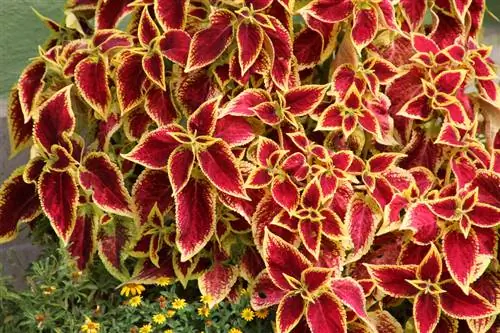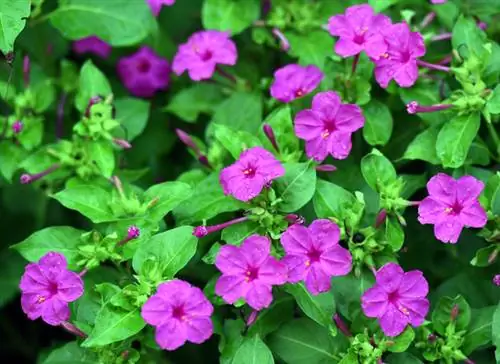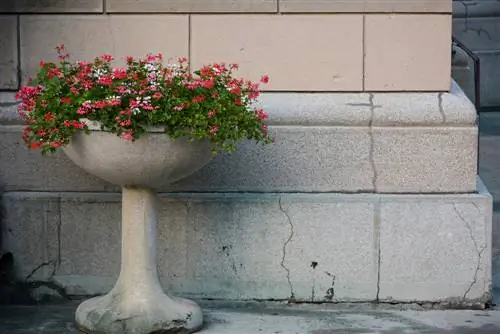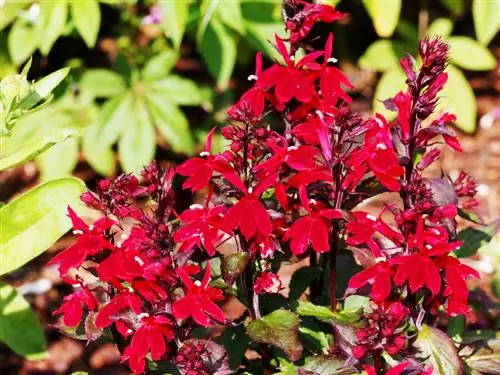- Author admin [email protected].
- Public 2023-12-25 17:45.
- Last modified 2025-01-23 11:20.
Their colorful, velvety-soft decorative leaves make a flower a minor matter. The coleus delights on the sunny balcony, as an opulent houseplant or shines in summer borders. Making the right choice within the overwhelming variety of varieties presents the gardener with a greater challenge than uncomplicated cultivation. The following answers to frequently asked questions explain why this is the case.
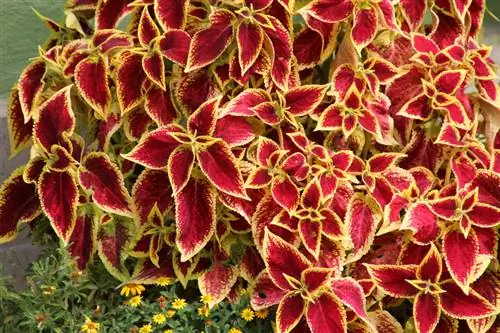
How do I properly care for a coleus?
Coleus nettles are easy-care, attractive plants that thrive in beds, pots or balcony boxes. Plant coleus in spring with loose, nutrient-rich substrate; water and fertilize them regularly. Care for them by trimming, pruning and, if necessary, overwintering.
Planting coleus correctly
Don't plant coleus in the bed until temperatures are consistently above 12-14 degrees Celsius. The leafy beauties can be planted in the pot all year round, as long as they are moved to the balcony no earlier than mid-May. Please pay particular attention to the following aspects:
- Thoroughly loosen the bed soil, weed and enrich it with acidic leaf compost or standard soil
- Use peat soil in the pot and balcony box with a few pieces of pottery as drainage over the bottom opening
- Place the root ball in lime-free water before unpotting until no more air bubbles appear
- Do not plant a young coleus deeper than just below the first pair of leaves
After you have watered the tropical grace generously, we recommend a mulch layer of leaves or grass clippings.
Care tips
The professional care of a coleus is primarily based on an ample supply of water and nutrients. All other measures follow this. How to do it right:
- Watere regularly and spray with soft water
- Fertilize weekly from May to September with liquid fertilizer for ericaceous plants
- Tail shoots that are too long to a maximum of 50 cm for bushy growth
If the mercury falls below 15 degrees in autumn, put coleus in the pot or balcony box. Cutting back by one to two thirds is now an advantage. In bright, warm winter quarters, water reduced and administer diluted liquid fertilizer every 4-6 weeks.read more
Which location is suitable?
The choice of location plays a key role in professional cultivation. In order for the tropical foliage plant to reach its floral zenith, these basic conditions are important:
- Bright, sunny location without direct sun at midday
- Warm and protected, preferably with high humidity
- Temperature minimum of 12-14 degrees Celsius
- Nutritious, fresh, moist soil with a neutral to slightly acidic pH value
Since Solenostemon cannot tolerate cold, they are moved to the sunny balcony or planted in the bed in May at the earliest.read more
What soil does the plant need?
Choose a nutrient-rich ericaceous soil as the potting substrate, as it has the required neutral to slightly acidic pH value. Alternatively, the use of standard compost-based soil is conceivable. The addition of lava granules or expanded clay ensures the desired permeability. Cultivated as an annual in the summer bed, enrich humus-rich, fresh, moist soil with acidic leaf compost or rhododendron soil so that the coleus develops splendidly.
When is flowering time?
From June to October, inconspicuous flower spikes rise above the magnificent foliage. Since these contribute little to the decorative appearance, experienced gardeners cut off the stems. Thanks to this foresight, you save a coleus the effort it takes to grow seed heads.
Cut coleus properly
Pruning at the right time provides a valuable service so that the vigorous coleus maintains its compact habit and does not become sparse. This is how it works:
- Prince the plant from the start to support bushy growth
- Consistently cut off the inconspicuous flower spikes
- Short it down by one to two thirds before putting it away for winter quarters
Continuous sharpening does not necessarily require the use of scissors. Hold the shoot just above a leaf or leaf node between your thumb and forefinger and snap it off.
Watering coleus
Water your coleus abundantly and regularly. The Asian beauty reacts angrily to dried substrate by shedding leaves for a short period of time. This may be necessary every day in summer on a sunny balcony or bright windowsill. Ideally, you should use soft water so that the pH in the soil does not increase. Pamper the tropical foliage plant every now and then with a gentle mist of lime-free water in the early morning or in the evening.
Fertilize coleus properly
The nutrient requirements of a coleus are at a high level. In pot culture, apply a liquid fertilizer for ericaceous plants weekly from May to September. Alternatively, apply a slow-release fertilizer as sticks, cones or granules in April and July. If the Solenostemon overwinters on the warm windowsill, a dose of liquid fertilizer every 4-6 weeks is sufficient.
Wintering
If the temperatures drop below 15 degrees Celsius in autumn, put coleus in the pot and balcony box. The decorative foliage plants stay in the bright, warm winter quarters or on the sunny windowsill until next spring. Adjust the water supply to the reduced demand. Fertilize every 4-6 weeks with diluted liquid fertilizer. In April, repot the overwintered leaf beauties into fresh substrate and gradually accustom them to more sunshine and warmer temperatures.read more
Propagate coleus
Propagate coleus easily with cuttings. To do this, cut head cuttings with a length of 10-12 cm in late summer. The lower part is defoliated so that the cuttings can be placed in pots with a poor substrate. A plastic hood creates a warm, humid microclimate that promotes rooting. Keep the soil constantly moist in a partially shaded, warm window spot. Until next spring you will cultivate a vital young plant.read more
Coleus in a pot
Use ericaceous soil or standard soil in the pot as a substrate to meet the desire for a slightly acidic pH value. To prevent waterlogging later, place a piece of clay over the opening in the floor. In a sunny, warm location on the balcony or windowsill, water the coleus abundantly and regularly with soft water. From May to September, fertilize weekly with a low-lime liquid fertilizer. Thoroughly trim shoots that are too long, because from a height of 40-50 cm the plant takes on a sparse habit. In winter, the tropical plant prefers a bright location with temperatures not below 15 degrees Celsius.
Is coleus poisonous?
Coleus is classified as a slightly poisonous plant. Since the cheerfully colorful leaves could tempt curious children and pets to eat them, the ornamental leaf plant is not ideal for the family garden. Gardeners who are sensitive to essential oils should carry out planting and care work with protective gloves.read more
Beautiful varieties
Coleus was formerly known by its botanical name Coleus blumeii. In modern taxonomy, the foliage plant is listed as Solenostemon. Since this change occurred recently, you will see the plant commercially available under both names.
- Goldmarie: A dream in velvety-soft golden yellow with greenish ruffled leaf edges; Growth height 30-60 cm
- Brilliancy: This Solenostemon hybrid stands out with carmine red, delicate yellow leaves; Growth height 30-50 cm
- Sunset: A premium variety with reddish leaves adorning a golden yellow center; Growth height 30-50 cm
- Black Dragon: A striking beauty with purple-red foliage and dark, curved borders; Growth height 50 cm
- Pink Rainbow: Magnificent color festival with copper-red, green-edged leaves, veined in crimson; Growth height 40-60 cm

